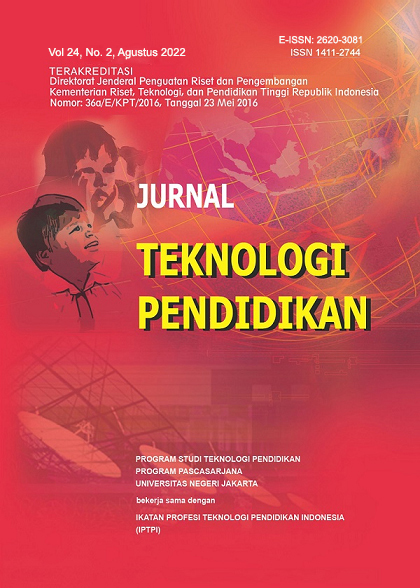Utilization of Educational Technology in The Learning Process in The Sub-District of Tebas, Sambas Regency
Abstract
This study aims to determine the use of educational technology in the learning process for educators in Tebas District, Sambas Regency, the theoretical use of research to contribute to the development and use of educational technology and practically to be able to apply the development of educational technology today. The variables in this study are Utilization of educational technology in the learning process" with indicators of learning models, learning strategies, learning methods, learning media and learning outcomes. The research method uses descriptive verification method in the form of case study research. The results of the study showed that the models, strategies, methods and learning media as well as learning resources most of the educators had mastered and could be applied, and it should be noted that the facilities and infrastructure that can support the use of educational technology such as internet facilities, wifi and equipment to support the implementation of learning when they want to implementing educational technology in delivering lesson messages and the lack of availability of learning resources in supporting the smooth process of using technology other than the teacher concerned.
References
Afriansyah, H. (2019). Pengembangan Model Pembelajaran Virtual (Mpv)Berbasis Video E-Learning Moodle. Jurnal Bahana Manajemen Pendidikan, 52–58.
Agustian, N., & Salsabila, U. H. (2021). Peran Teknologi Pendidikan dalam Pembelajaran. Islamika, 3(1), 123–133. https://doi.org/10.36088/islamika.v3i1.1047
Arikunto, S. (2010). Prosedur Penelitian. Suatu Pendekatan Praktik. Jogyakarta: Rineka Cipta.
Aunurrahman. (2009). Belajar dan Pembelajaran. Bandung: Alfabeta.
Bruce, J., & Marsha, W. (2011). Model Of Teaching 8th (ed.). New Jersey: Prentice -Hall, Englwood Cliffts.
Daryanto. (2013). Strategi dan Tahapan Mengajar, Bekal Keterampilan Dasar Bagi Guru . Bandung: Yrama Widya.
Djamarah, S. d. (2010). Strategi Belajar Mengajar. Jakarta: Rhineka Cipta.
Donald, E. P. (2002). Trends in Educational Technology., Fifth Edition. New York: Eric Clearing House On Information & Technology Syracuse University.
Effendi, D., & Wahidy, A. (2019). Pemanfaatan Teknologi dalam Proses Pembelajaran Menuju Pembelajaran Abad 21. Prosiding Seminar Nasional Pendidikan Program Pascasarjana Universitas PGRI Palembang, 125–129. https://jurnal.univpgri-palembang.ac.id/index.php/Prosidingpps/article/view/2977/2799
Efgivia, M. G. (2020). Pemanfaatan Big Data Dalam Penelitian Teknologi Pendidikan. Educate: Jurnal Teknologi Pendidikan, 5(2), 107–119. https://doi.org/10.32832/educate.v5i2.3381
Eliya Rochmah, N. W. (2018). Membangun virtual classroom melalui social learning networks (SLNS). Premiere Educandum: Jurnal Pendidikan Dasar dan Pembelajaran Vol. 8.
Gideon, S. (2018). Peran Media Bimbingan Belajar Online Ruangguru” Dalam Pembelajaran Ipa Bagi Siswa Smp Dan Sma Masa Kini: Sebuah Pengantar. JDP Volume 11, Nomor 2, Juli, 167-182.
Hanum, N. S. (2013). Keefektifan E-Learning Sebagai Media Pembelajaran. Jurnal Pendidikan Vokasi, Vol 3, Nomor 1, Februari.
Imam Fitri Rahmadi, K. C. (2018). Kebutuhan Sumber Belajar Mahasiswa yang Mendukung Pembelajaran Berbasis Teknologi Informasi dan Komunikasi di Perguruan Tinggi. Jurnal Teknologi Pendidikan Vol. 20, No. 2.
Julaeha, S. (2006). Virtual Learning:Pemanfaatan Teknologi Informasi Dan Komunikasi Untuk Meningkatkan Kualitas Pembelajaran. Universitas Terbuka.
Khaerudin. (2014). Penilaian Kebutuhan Pemanfaatan E-Learning. Jurnal Parameter Volume 25 No. 2.
Khaerudin. (2019). Trend Penelitian Penyelesaian Studi di Program Studi Teknologi Pendidikan. Jurnal Teknologi Pendidikan.
Meizi Syafri Yendi, A. F. ( 2020). Pengaruh Bimbingan Belajar Online (Ruangguru) dan Minat Belajar Terhadap Hasil Belajar Ekonomi Kelas X di SMA Negeri 3 Padang. Ecogen Vol. 3 No. 1, 5 Maret, 87-94.
Miarso, Y. (2007). Menyemai Benih Teknologi Pendidikan. Jakarta: Kencana.
Ramadhayanti, A. (2018). Analisis Strategi Belajar Dengan Metode Bimbel Online Terhadap Kemampuan Pemahaman Kosa Kata Bahasainggris Dan Pronunciation (Pengucapan/Pelafalan) . Jurnal Kredo Vol. 2 No. 1 Oktober.
Said, H. (2014). Pengembangan Model Pembelajaran Virtual Untuk Meningkatkan Efektivitas Pembelajaran Pada Madrasah Negeri di Kota Parepare. Lentera Pendidikan, Vol. 17 No. 1 Juni , 18-33.
Seel, N. M. (2004). Curriculum, Plans,And Processes In Instructional Design. London: Lawrence Erlbaum Associates, Publishers.
Siregar, Z., & Marpaung, T. B. (2020). Pemanfaatan Teknologi Informasi dan Komunikasi (TIK) Dalam Pembelajaran di Sekolah. BEST Journal (Biology Education, Sains and Technology), 3(1), 61–69. https://doi.org/10.30743/best.v3i1.2437
Sukmadinata, N. S. (2012). Metode Penelitian Pendidikan. Bandung: Remaja Rosdakarya.
Sukmara, R. (2021). Project Based Learning Implementation for Improving Japanese Language Grammar Competence in Virtual Classroom. JAPANEDU: Jurnal Pendidikan dan Pengajaran Bahasa Jepang Vol. 06, No. 1, 83-88.
Sutikno, S. (2013). Belajar Dan Pembelajaran, Upaya Kreatif Dalam Mewujudkan Mewujudkan Pembelajaran Yang Berhasil. Lombok: Holistica.
Syamsurijal. (2019). Survey Kepuasaan Siswa yang Berlangganan Ruang Guru. PERNIK Jurnal PAUD, VOL 2 NO.1 April.
Undang-Undang Republik Indonesia Nomor 20 Tentang Sistem Pendidikan. (2003). Jakarta.
Copyright (c) 2022 Warneri, Okianna

This work is licensed under a Creative Commons Attribution-ShareAlike 4.0 International License.
Jurnal Teknologi Pendidikan is an Open Access Journal. The authors who publish the manuscript in Jurnal Teknologi Pendidikan agree to the following terms.
Attribution-ShareAlike 4.0 International (CC BY-SA 4.0)
-
Attribution — You must give appropriate credit, provide a link to the license, and indicate if changes were made. You may do so in any reasonable manner, but not in any way that suggests the licensor endorses you or your use.
-
ShareAlike — If you remix, transform, or build upon the material, you must distribute your contributions under the same license as the original.
- No additional restrictions — You may not apply legal terms or technological measures that legally restrict others from doing anything the license permits.
Notices:
- You do not have to comply with the license for elements of the material in the public domain or where your use is permitted by an applicable exception or limitation.
- No warranties are given. The license may not give you all of the permissions necessary for your intended use. For example, other rights such as publicity, privacy, or moral rights may limit how you use the material.







